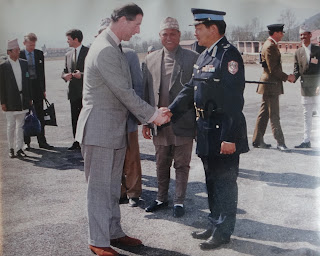2/5 Gorkha Rifles was in Iraq during 1917 AD
In his Foreword of IInd volume of History of the Fifth Royal
Gurkha Rifles (Frontier Force), Field Marshal W. J. Slim writes:
"…Between the 1940 and 1945 I had the good fortune to
have serving under me in various theaters of war all four battalions of the 5th
Gurkhas. They were always among my best fighting battalions and unsurpassed for
discipline and turn-out, even in ther most difficult conditions. They held a
pride in themselves and in their Regiment that was magnificent and unshakeable.
All who served with them recognized the 5th
Gurkhas as a splendid example of what a Gurkha Regiment can be—and that there
is no higher praise. We know that to equal them in anything was to e very good
indeed at it; to surpass them to be all that and have a slice of luck too.
We, their old comrades, will read this history with a glow
of pride that we served with them and of sorrow that, while the 5th
Gurkhas still march on with their glories untarnished, it is, alas! no longer
at our side."
At the end of this history book, the epilogue by R. L. Turner,
1930, reads:
"As I write these last words my thoughts return to you
who were my comrades, the stubborn and indomitable peasants of Nepal. Once more
I hear the laughter with which you greeted every hardship. Once more I see you
in your bivouacs or about your fires, on forced march or in the trenches, now
shivering with wet and cold, now scorched by a pitiless and burning sun. Uncomplaining,
you endure hunger and thirst and wounds; and at the last your unwavering lines
disappear into the smoke and wrath o f battle. Bravest of the brave, most
generous of the generous, never had country more faithful friends than you."
After the bitter 1857 experience, Britain was determined to maintain a strong Gurkha Brigade in her Indian army. For this they needed fresh recruits annually from Nepal. Jung, however, was reluctant to supply these recruits as this would have not only expanded British influence but adversely affect his hold over Nepal as well. He, thus, refused to allow Gurkhas, on home leave, to wear their uniforms in Nepal and also strongly objected to recruiting parties (gallawalas) entering Nepal under any guise.23 So from 1878 the skilful British adopted the “guns for recruits” policy whereby fresh recruits from Nepal were acquired by supplying the guns/ammunition needed by the Nepalese army or by simply refusing to give recognition to the new Prime Minister24. This policy worked because when Bir Shumshere came to power after assassinating his own uncle, Ranoddip, in 1885 “He permitted the free enlistment of Gurkha recruits for the Native Army in India.”25 This signaled the first official recognition by Nepal of Gurkha recruitment into the British Indian army and Britain quickly expanded her Gurkha Brigade from five to ten regiments26. The policies of British India and the Rana government of Nepal, thus, fueled the “exclusion/expulsion” process of the “matwales” further. The Khas are recruited for the 9th Regiment while the Limbus and Rais are recruited into the 7th and 10th Regiments. For the rest of the other seven Regiments “almost the only men enlisted are Magars and Gurungs”.27 Vansittart, who had a penchant for details, gives an interesting figure of 36,107 recruits from Nepal recruited during the period 1894/’95 to 1912/’13.
https://docs.google.com/document/d/18Kfpcv89IA9q0k85PjFenfn5ghaMEP9tgRND8y-jJS4/edit


